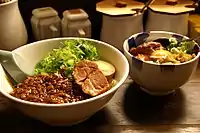Zhajiangmian
Zhajiangmian (Old Beijing Noodles with Fried Bean Sauce) (Chinese: 炸醬麵; lit. 'fried sauce noodles'), or "noodles with soybean paste", is a Chinese dish consisting of thick wheat noodles topped with zhajiang sauce. Zhajiang sauce is normally made by simmering stir-fried ground pork or beef with salty fermented soybean paste. Zhajiang also means "fried sauce" in Chinese. Although the sauce itself is made by stir-frying, this homonym does not carry over into the Classical Chinese term.
 | |
| Type | Chinese noodles |
|---|---|
| Place of origin | China |
| Region or state | Shandong |
| Main ingredients | cumian, ground pork, zhajiang (fermented soybean paste) |
| Zhajiangmian | |||||||||
|---|---|---|---|---|---|---|---|---|---|
| Chinese name | |||||||||
| Traditional Chinese | 炸醬麵 | ||||||||
| Simplified Chinese | 炸酱面 | ||||||||
| Literal meaning | fried sauce noodles | ||||||||
| |||||||||
| Korean name | |||||||||
| Hangul | 작장면/자장몐 | ||||||||
| Japanese name | |||||||||
| Kanji | 炸醤麺 | ||||||||
| Kana | ジャージャー麺 | ||||||||
The topping of the noodles usually are sliced fresh or/and pickled vegetables, including cucumber, radish, edamame, depending on regions. Chopped omelette or in lieu of extra firm tofu can also be alongside. Low-fat dieters often use minced skinless chicken for the meat portion.
History
Origin
Zhajiangmian originates from Shandong province and is an iconic Northern Chinese dish. It is unknown how the dish came to be and only a few folktales are available.[1]
Spread of vegetarian Zhajiangmian to Beijing
During the Guangxu era of the Qing dynasty, after the Eight-Nation Alliance invaded China and conquered Beijing, the Empress Dowager Cixi, Emperor Guangxu and their retinues were forced to retreat from Beijing to Xi'an. On their way, the Imperial Eunuch, Li Lianying detected a pleasant aroma, and found that the smell came from a zhajiangmian restaurant. He then reported about the restaurant to Cixi and Guangxu. Due to collective fatigue and hunger after their long trip, Cixi and Guangxu decided to have a meal in the restaurant. Li Lianying ordered a bowl of vegetarian zhajiangmian. Finding it tasty, they ordered another one. After dinner, Cixi asked everyone how they found the taste of the dish. They all replied "This is definitely a good noodle. Good, good!"[1] Shortly after, as Emperor Guangxu was about to leave and continue their trip, Cixi demanded that Li Lianying bring the chef who made the zhajiangmian to Beijing and the palace, so they could eat zhajiangmian often once they came back. This is the story of how the vegetarian zhajiangmian made its way to Beijing.[1]
Analysis of the subjective factors such as Beijing city development in Qing and Ming dynasties, food supply, climate, people' s living conditions comes to a conclusion that Bean Paste Noodles and Old Beijing Noodles with Fried Bean Sauce occurred at the same time.The symbolic sign"Old Beijing Noodles with Fried Bean Sauce"is hidden but rich in profound cultural connotation.[2]
Types
Shandong
In Shandong cuisine, the sauce is made with tianmianjiang and this version of zhajiangmian is commonly viewed as the standard within China.
Beijing
In Beijing cuisine, yellow soybean paste is used to make the sauce.
Tianjin
In Tianjin cuisine, bean paste is used to make the sauce.
Guangdong
In Cantonese cuisine, hoisin sauce is used to make the sauce.
Sichuan
In Sichuan cuisine, doubanjiang is used to make the sauce.
Northeast China
In Liaoning and Jilin, the sauce is traditionally fried with doenjang due to the influence of Korean-Chinese people in these areas.
Hong Kong
In Hong Kong cuisine, ketchup is used to make the sauce.
Buddhist
A vegetarian version of zhajiang sauce may be made by substituting ground beef or pork with finely diced extra firm smoked tofu (熏豆腐乾), edamame (毛豆), eggplant, or extra firm tofu (素雞). The vegetarian versions generally call for soybean paste of any sort instead of soy sauce, since the tofu chunks are larger and need more structure.
Islamic
A halal version is often made with ground beef or lamb.
South Korea
In South Korea, zhajiangmian has evolved into jajangmyeon when workers from Shandong were sent by the Chinese military to Korea.[3]
Japan
In Japan, zhajiangmian evolved into jajamen (じゃじゃ麺) when it was brought from Northeast China.[4] It is a popular dish in the northern Japanese city of Morioka, Iwate and is known as one of the three great noodle dishes of Morioka (盛岡三大麺).
See also
| Wikimedia Commons has media related to Zha jiang mian. |
External links
References
- "说一说炸酱面的来历-好豆网". www.haodou.com. Retrieved 2018-04-03.
- "The Historical Study on Old Beijing Noodles with Fried Bean Sauce--《Culinary Science Journal of Yangzhou University》2009年04期". en.cnki.com.cn. Retrieved 2020-06-29.
- Chinese, Korean and Japanese Versions of One Noodle Bowl and Where to Find Them, Westword
- "じゃじゃ麺の歴史" (in Japanese). Retrieved 22 August 2020.


.jpg.webp)

.jpg.webp)